Why do red spots appear on gooseberry leaves and how to deal with it
Red spots on berries, leaves and other parts of the gooseberry are a frequent occurrence when agrotechnical measures are not followed, the plant is not processed in time. To protect all plantings on the site and prevent the loss of the crop, it is important to know how to distinguish between diseases and what to do if the leaves turn red.
The content of the article
Why gooseberry leaves and berries turn red
The gooseberry is picky about care, from year to year it gives a bountiful harvest, but, like other plants in the summer cottage, it is affected pests and diseases.
He is most susceptible to fungal diseases.... The plant signals the problem by changing its appearance.
Red leaf spots and berries - the main symptom of diseases such as powdery mildew, anthracnose, septoria, scab, alternaria.
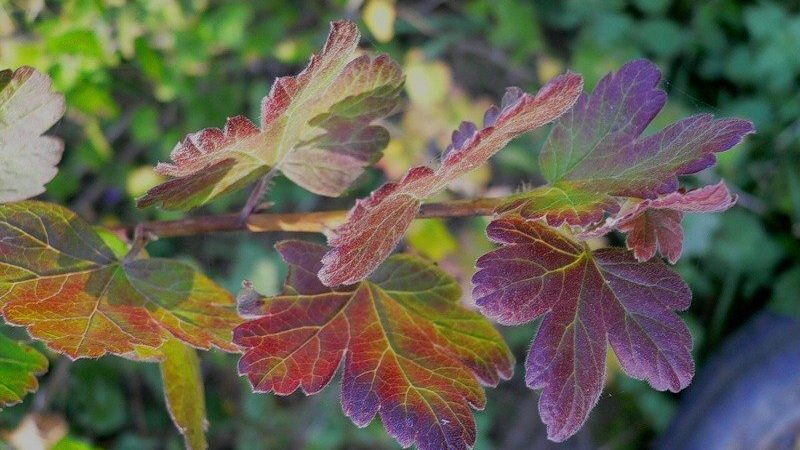
Spheroteka, or powdery mildew
The leaves on the gooseberry turn red already at the final stage of the disease. The first signs of fungal activity are noticeable after flowering. White bloom appears on young leaves and shoots. Over time, it spreads to fruits and ovaries, gradually changing color to brown.
For reference. Spheoteka, like other fungal diseases, develop at high air humidity, in dry, nitrogen-saturated soil.
Anthracnose
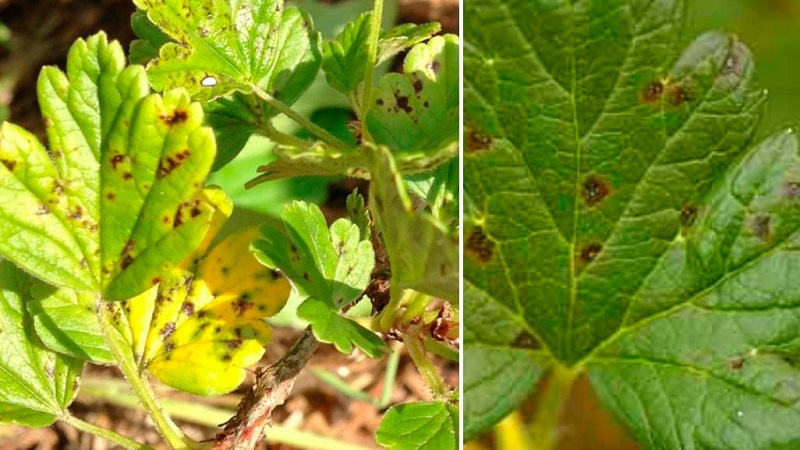
The first symptoms appear at the end of flowering.... The disease can be identified by small angular-rounded brown spots on the leaves. Over time, they merge and acquire a brown tint. On berries, stalks and other parts of the gooseberry, anthracnose appears in the form of small dark ulcers, which crack during drought, and rot in rainy weather.
Septoriasis
It appears as brown spots on the leaves and fruits of the gooseberry. Gradually, the core of the spot turns white and becomes transparent. A brown border remains.
For reference. For all fungal diseases, brown, red spots on berries and leaves are a sign of the development of fungal spores.
Scab
The appearance of dark brown spots on the leaves of the gooseberry can also be characterized by scab. Over time, the spots grow and spread to berries, shoots. The plant is deformed, slows down in growth, dies.
Alternaria
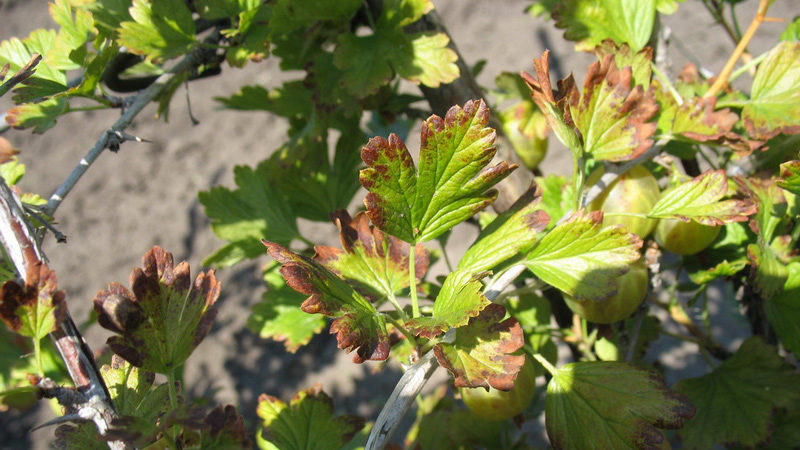
On the leaves of the plant, spots of various shapes appear in dark brown color with bright edging along the edges. It is difficult to notice signs of infection on the berries, since the spores of the fungus develop inside the fruit (they get there during the period of active flowering), turning the core into rot and mold.
Among the secondary signs, it is worth highlighting:
- premature shrub drying;
- leaf deformation;
- drying out of berries.
Recommended to inspect planting gooseberries at least once every 7 days. Ignoring the disease and untimely actions will lead to loss of yield and death of the shrub.
How to fight
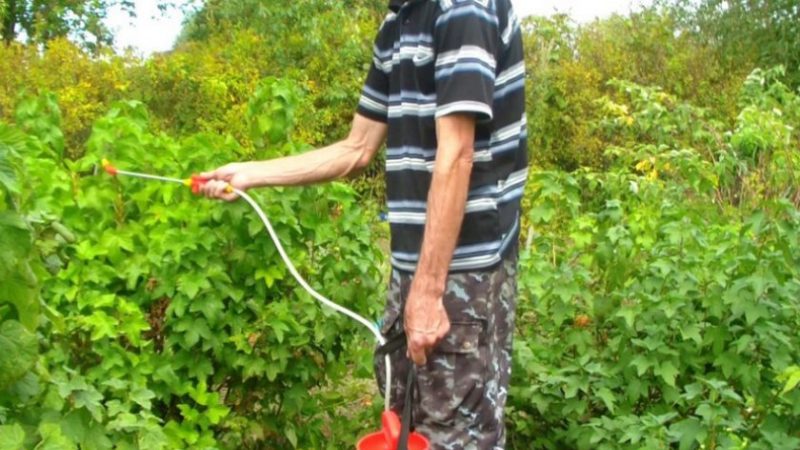
If a red gooseberry has a stain on the side or other parts of the plant, and the shrub dries up, you need to take immediate action.
Fighting fungal diseases requires:
- Disposal of diseased shoots and fruit.
- Planting treatments with chemical, biological and folk remedies.
Destruction of infected leaves and berries
Areas with a large lesion are removed to healthy tissue and burned. Places of cuts are disinfected with 1% solution of copper sulfate or covered with garden varnish. The remaining bushes are processed drugs.
Important! After trimming the material, it is imperative to disinfect garden tools as well.
How to process
How to process gooseberries if berries and leaves turn red:
- Folk remedies. The treatment will be effective if the disease was diagnosed in a timely manner, and the fungus did not have time to infect most of the plant.
- Biologicals. Their advantages include harmlessness to the crop and strengthening the plant's immunity.
- With chemicals. They are used in extreme cases when other measures have proved ineffective.
Microbiological preparations are used no earlier than 14 days after the last chemical treatment. The latter are used after biological agents without reference to terms.
Traditional methods
Folk methods are notable for safety, but low efficiency. It is wiser to use them at the stage of prevention.
More often, gardeners use:
- Boiling water. A dormant bush is processed immediately after the snow melts. The method is not suitable if the kidneys are already swollen. It is also important not to overdo it with boiling water so as not to wake the plant up prematurely. For the death of all microorganisms, spray boiling water and thoroughly moisten all the shoots. For best efficiency, you can add soda or salt (3-5 tbsp for 1 bucket).
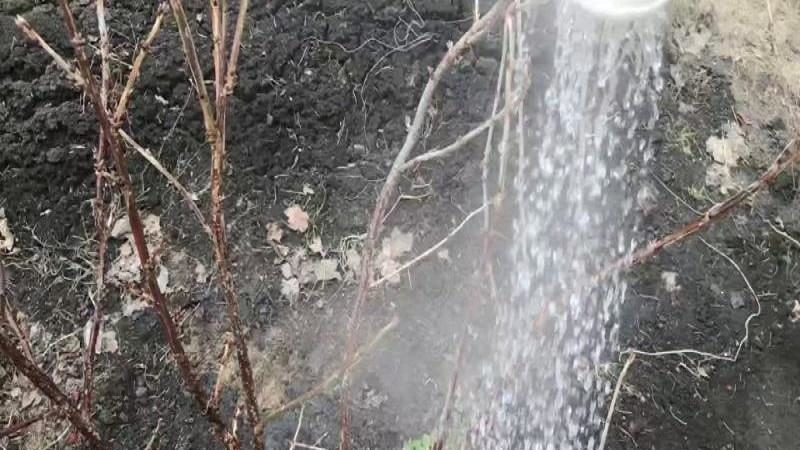
- Baking soda / soda ash. Exposure to alkali is detrimental to fungi. To prepare the solution, dilute 100 g of baking soda in 10 liters of water. Use before bud break. Soda ash is more aggressive, so the dosage is halved (50 g of substance per 10 liters of water).
- Laundry soap... Alkaline agent, in addition to affecting pathogens, envelops the surface of the plant with a protective film. To prepare the solution, rub 50 g of soap and pour 2 liters of boiling water. Stir thoroughly and add another 8 liters of water.
Biofungicides
They have a short duration. They are water-soluble, which requires repeated treatments at least 1 time in 5-7 days.
Fitosporin
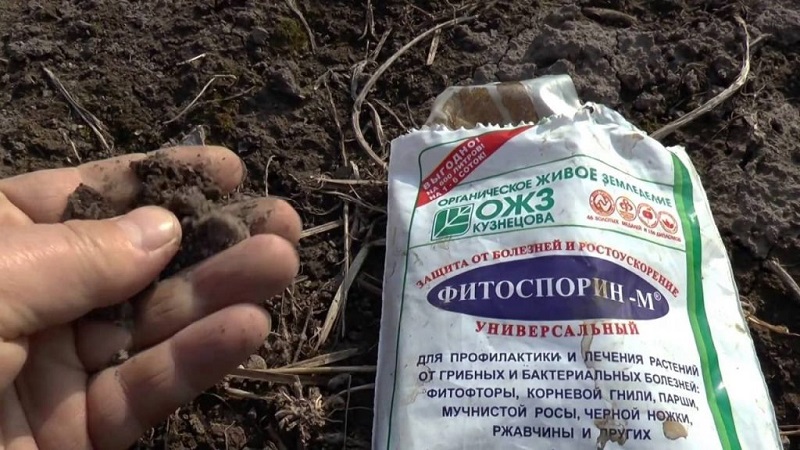
A systemic remedy based on a spore culture. Harvest-safe, can be used at any stage of plant development. Available in the form of an aqueous suspension, powder and paste.
The bushes are processed in cloudy weather or late in the evening, since the product is sensitive to sunlight.
A working solution is prepared 2 hours before processing, strictly following the manufacturer's recommendations. Do not use tap water because of the high chlorine content. Better to give preference to boiled, rain or melt water. When using a paste, a concentrated solution is prepared, which is diluted before processing.
For better adhesion of the drug, liquid soap can be added to the working mixture - 1 ml per 10 liters.
"Trichodermin"
A preparation with a pronounced fungicidal effect based on bioactive substances released during spore germination. It does not affect the taste and nutritional qualities of the crop, therefore it is considered safe and harmless. Berries can be consumed even on the day of processing.
It is sold in the form of a dry powder and an aqueous suspension. To prepare a medicine from dry powder, mix 1 package (10 g) with 1 liter of warm water. The drug is administered gradually, stirring continuously. Then leave for several hours at room temperature. Use the prepared solution within 6 hours.
Chemicals
Water-soluble preparations are often used - broad-spectrum fungicides. They are toxic, but they have a prolonged duration of action. 2-3 treatments are enough per season.
Important! Fungicides require precautions. For safety reasons, you need to use only certified drugs, work in overalls.
It is not recommended to use the same drug on an ongoing basis, it is better to alternate with analogues.
Bordeaux mixture
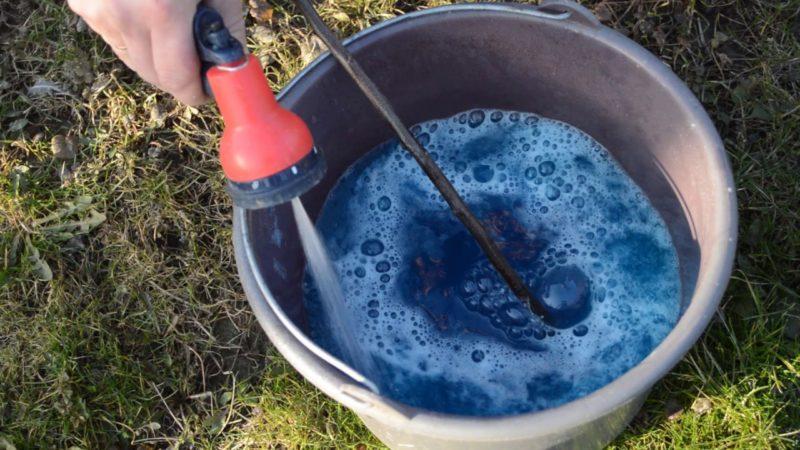
Contact action pesticide. Consists of copper sulfate, lime and water. Protects gooseberries for 30 days after application.
With a slight infestation of shrubs, 3 treatments are enough: before leafing out, at the beginning of the growing season and after flowering. In case of large damage to plants, it is recommended to increase the number of treatments to 6. The last irrigation should be 2-3 weeks before harvest.
"Topaz"
Penconazole based highly effective fungicide... It is not phytotoxic, it remains in the soil for a long time. Suppresses the growth of mycelium 3 hours after the initial application. The active ingredients are quickly absorbed by plant tissues, which does not tie the use of the drug to weather conditions.
Available in emulsions of 1 liter and 2 ml. One ampoule of concentrate is diluted in 10 liters of water. During the season, 3-4 treatments are enough with a frequency of 21 days.
Fundazol
Benomyl-based fungicide. In the first 3 days after treatment, it suppresses the mycelium, destroys its cells. The next 7 days acts as a protective agent. Sold in powder form. To prepare a solution, 1 g of the drug is diluted in 1 liter of water. If the time interval is observed, repeated processing of plants is permissible.
"HOM"
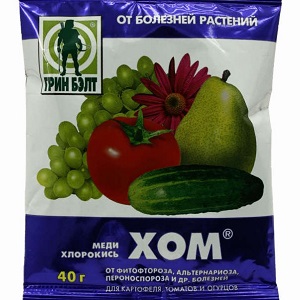
Contains copper oxychloride, used as a substitute for Bordeaux mixture. Available in powder form. The average rate is 40 g of the drug per 10 liters of water.
First, a mother liquor is prepared in a small amount of water, then it is brought to the required volume by adding water with constant stirring.
It is used only in calm weather, during the period with the least chance of rain. Gooseberries are processed before and after flowering.
"Abiga Peak"
The preparation is based on copper oxychloride, but the treatment is not tied to weather conditions. The only condition is that the temperature is not lower than + 9 ... 11 ° C.
Preparation of the mixture requires strict adherence to the instructions: a bottle with an aqueous suspension is diluted in 1 liter of water, then another 10 liters is added to the mother liquor, everything is thoroughly mixed.
Processing takes place by spraying. The bushes are processed in 2 stages with a time interval of 20 days.
Attention! Gooseberry is one of the earliest honey plants, so during the spring processing it is better to use preparations that are safe for bees.
Preventive measures
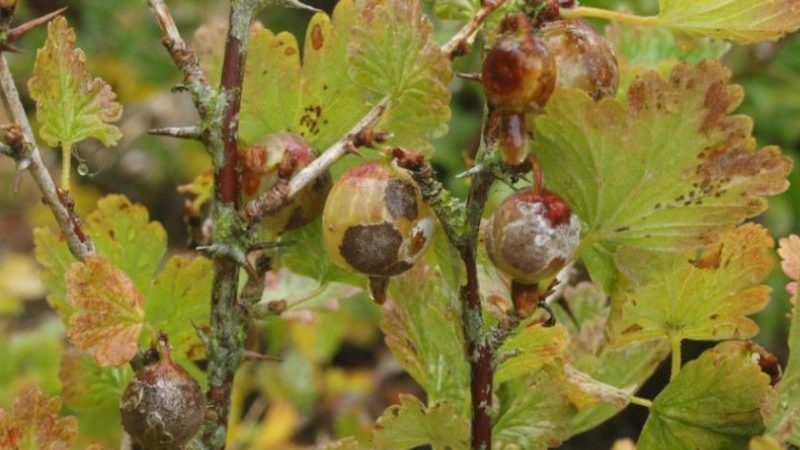
Despite the fact that fungal diseases can be treated with timely diagnosis, it is better to carry out prevention on time:
- Observe agricultural practices.
- Timely cleanse of plant debris (weeds, fallen leaves, cut branches), burn it.
- Prevent thickening of plantings.
- To carry out sanitary pruning of old shoots, low-growing, weak and dry branches annually in spring. Process the sections of thick shoots with garden pitch.
- Fertilize plants with root and foliar dressings.
- Have a hot shower in early spring. This procedure prevents infection of the plant.
- Grow garlic, mint, calendula and other herbs with a pronounced aroma in the vicinity of gooseberries.
Conclusion
Gooseberries are vulnerable to fungal infections. The activity of mycosis can be judged by the specific spots on the berries. Timely control of mycelium will help preserve crops and plants. Compliance with agrotechnical methods of plant protection and disease prevention are also important factors.